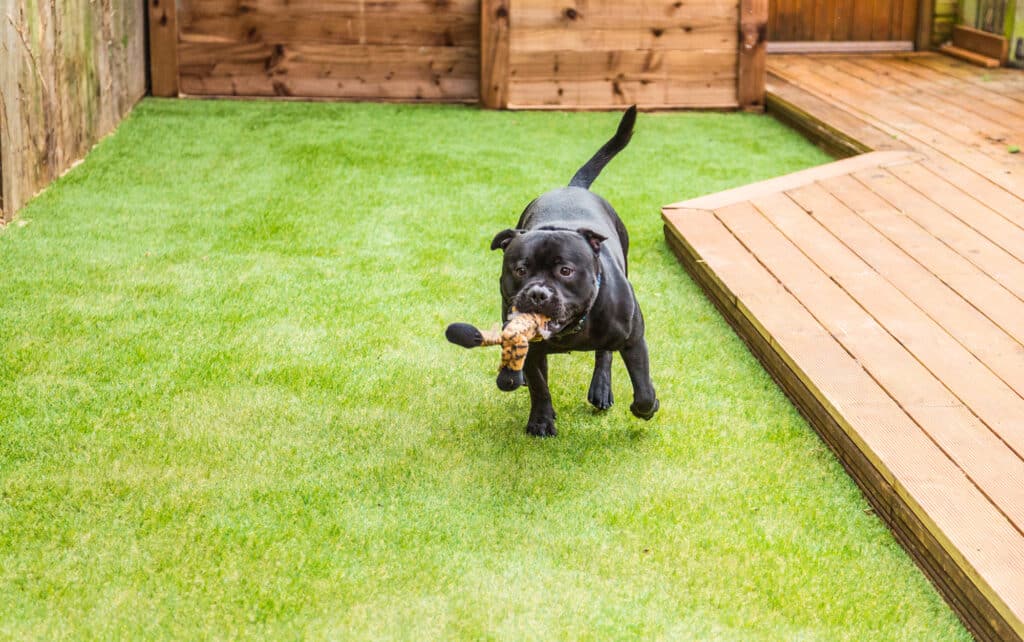Looking to create a low-maintenance, year-round play space for your furry friend? Artificial turf might be the perfect solution! It offers a clean and convenient alternative to natural grass, eliminating the hassle of mowing, watering, and muddy paws. In this comprehensive guide, we’ll walk you through the steps of installing artificial dog turf yourself, transforming your backyard into a dog paradise.

Why Choose Artificial Turf for Dogs?
Artificial turf for dogs is designed specifically to be durable, pet-friendly, and low-maintenance. Unlike natural lawns, synthetic turf remains green and lush without the need for watering or mowing. It’s perfect for dog owners who want to keep their backyard looking pristine year-round, regardless of the weather or how much their pets play.
Pet-friendly artificial grass is also an excellent choice for dog parks, boarding facilities, doggie daycares, and even veterinary clinics. It provides a safe and comfortable surface for dogs to play on, free from mud, dirt, and other debris. Plus, artificial grass that is safe for pets can help reduce the risk of ticks and fleas. Explore why artificial grass is perfect for pet facilities.
Before You Dig In: Planning and Materials
Measure Up:
Accurate Measurements: Begin by accurately measuring your designated turf area. This will help you purchase the correct amount of pet turf rolls, ensuring you account for some extra for seams and edging. Measure in square feet or square yards, depending on your preference.
Gather Your Supplies:
Artificial Turf Designed for Pets: Ensure the turf you choose has proper drainage to handle pet waste and has antimicrobial properties to keep it odor free.
Landscape Edging: Choose from plastic, metal, or concrete to give a clean finish.
Weed Barrier Fabric: To prevent unwanted weeds from growing through your new turf.
Shovel and Rake: Essential for excavation and leveling.
Utility Knife: For precise cutting of the turf.
Tamper (Plate Compactor): Optional but recommended for larger areas to compact the base.
Sand Infill: Opt for pet-specific silica sand for the best results.
Seam Tape: For connecting turf seams.
Landscape Staples or Nails: To secure the turf.
Getting Ready for the Turf
Excavation: Carefully remove existing soil, grass, weeds, and debris from the designated area. Aim to dig down 2-4 inches, creating a level base. This will help eliminate any smell that might come from soil underneath and ensure a durable surface.
Laying the Foundation: Install weed barrier fabric to prevent weed growth. Overlap the edges and secure them with landscape staples.
Drainage is Key: For proper drainage, consider adding a crushed gravel base (1-2 inches thick) on top of the weed barrier. Compact the gravel with a tamper for a solid foundation. A good drainage system is crucial to prevent water from pooling on your pet turf.
Pro Tip: For areas with poor drainage, consider adding a perforated drainage pipe beneath the gravel layer to ensure superior drainage.
Installing the Turf
Unroll and Relax: Unroll the turf in warm weather (ideally above 70°F) to allow the fibers to relax and flatten out any creases. Direct sunlight can help the turf fibers relax.
Seaming: If using multiple turf pieces, lay them seam to seam and use seam tape to create a secure, invisible connection.
Trimming and Edging: Carefully trim the turf to fit the designated area. Secure the edges with landscape edging of your choice, following the manufacturer’s instructions.
Securing the Turf: Once everything is in place, use landscape staples or nails (every 4-6 inches) to secure the turf perimeter to the underlying base. Ensure there are no gaps to prevent digging or tearing.
Finishing Touches: Infill and Brushing
Infill Magic: Spread pet-specific silica sand infill evenly over the turf. The infill helps the blades stand upright, provides drainage, and weighs down the turf. It also helps keep the turf cool, which is ideal for areas with southern exposure.
Brushing for Perfection: Use a stiff bristle brush to work the infill down into the turf blades, ensuring an even distribution.
Top Up and Enjoy!: After some playtime, the infill may settle. Top up any areas that seem lacking and brush again for a consistently lush and functional surface.
Congratulations!
Your pup now has a fantastic new play area to enjoy. Remember to regularly hose down the turf to remove pet waste and debris, and brush occasionally to maintain drainage and prevent matting.
Bonus Tip: Consider adding a cleaning solution specifically designed for artificial turf to your cleaning routine for an extra layer of sanitation. This is especially important for areas with high pet activity.
With a little planning and effort, you can create a dog-friendly haven using artificial pet turf. Enjoy watching your furry companion play and relax on their new green paradise!
Additional Tips for Pet Turf Installation and Maintenance
Choose Ideal Turf: Selecting the right turf products is crucial. Look for synthetic grass with antimicrobial properties and a good drainage system.
Consider the Environment: If you have trees or shade in your yard, ensure the turf you choose can handle low-light conditions. Some turfs perform better in direct sunlight, while others are suited for shade.
Handling Different Weather Conditions: Artificial turf is versatile and can withstand various weather conditions, from hot summers to snow in winter. However, it’s essential to regularly check for any signs of wear or damage.
Safety First: Ensure your turf is free from heavy metals and other harmful substances to keep it safe for your pets and children. Pet-friendly turf is specifically designed to be safe for animals and other pets.
Durability: A durable turf will resist tear and damage from active pets. It also requires little water for maintenance, making it an eco-friendly option.
Multipurpose Use: Artificial turf is not just for pets. It provides a great play area for kids, and you can place children’s toys on it without worry. It’s also an excellent surface around a fire pit or in areas where regular turf struggles to grow.
By following this guide, you’ll be able to create a durable, low-maintenance play area for your dog that stays green and clean all year round. Whether you are a pet owner looking to improve your lawn care or managing a dog park, boarding facility, or veterinary clinic, pet-friendly turf is the ideal solution. Happy DIY-ing!
Comparing Pet Grass and Real Grass
While real grass and natural lawn have their benefits, they often require extensive maintenance and are prone to damage from pet activity. Pet grass, on the other hand, is specifically engineered to withstand the wear and tear caused by pets. It stays green and vibrant without the need for watering, mowing, or the application of fertilizers and pesticides. Additionally, pet grass is designed to be safe and comfortable for your pets, providing a durable and easy-to-maintain alternative to natural lawns.
Choose pet grass for a hassle-free, beautiful yard that both you and your pets will love.
